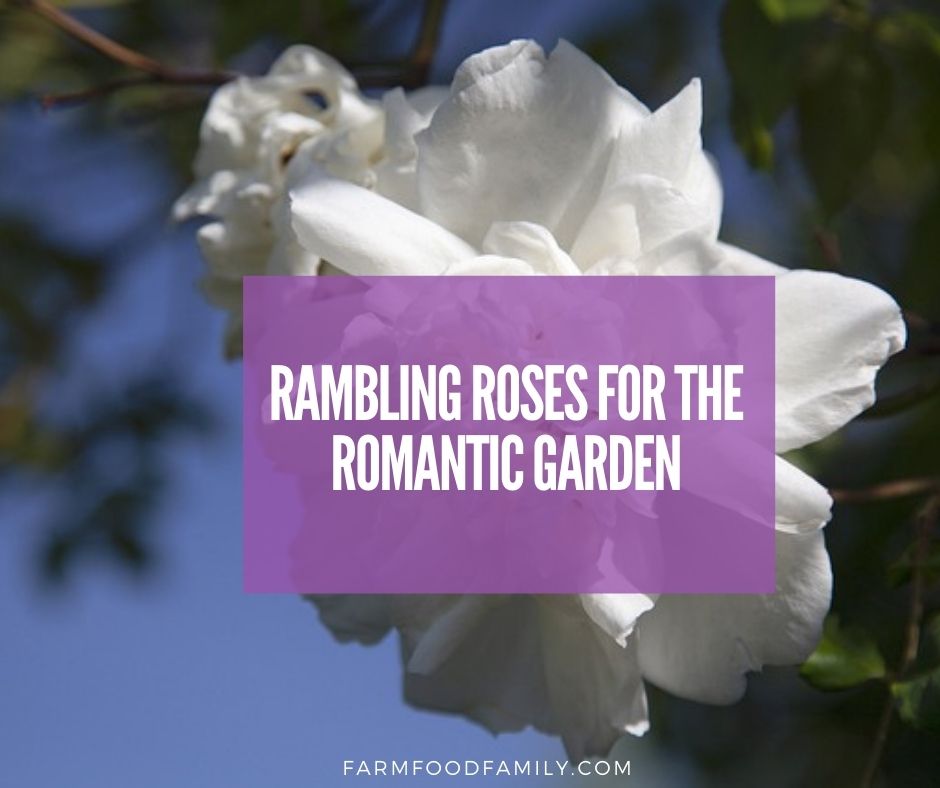Rambling roses are best in care-free romantic gardens. Like children, they tumble over walls, scramble through fences and climb into trees – happiest when left alone.
Rambling roses are generally more vigorous than climbing roses.
They are well-suited to semi-horizontal growth. The ramblers scramble along fences, tumble down hills, spill over walls and walkways and are even trained to grow up through trees.
They have an abundance of flower clusters and for gardeners with romantic tastes, rambling roses are a delightful addition the the garden.
What is a Rambling Rose?

By its very nature, the rambling rose is a superbly vigorous and floriferous rose. Most are crossed between R. wichuriana and R. multiflora. Both species together give the rambling rose its vigor, flower clusters, hardiness, size, flexibility and ability to travel both horizontally as well as vertically.
Ramblers became hugely popular in Victorian gardens. The need for roses in this period, brought rambling roses and rose culture into the mainstream. Gardeners wanted romance in the garden – that same over-stated exuberance they enjoyed inside their homes.
Planting and Caring for Rambling Roses

Rambling roses don’t need as much care and attention as modern hybrids or even climbing roses. This is a rose that is quite happy to be left alone, but there are a few things to note.
For rambling roses to be displayed at their best, they need a support. Arbors, fences, stone walls, trellises, trees and pillars are all good solid fixtures. With fences, the canes only need to be pulled through the rails for support. Pillars and other vertical structures will need O-hooks attached so that the rose can be tied in.
The rambler requires the same planting culture as any other rose – well-drained soil amended with compost or manure, as well as shovel-load of dampened peat moss mixed in. Roses grow well in clay soil with these amendments. Established roses appreciate a shovel load of well-rotted manure early each spring. Blend it into the top of the soil with a hand fork or cultivator.
There are some rambling roses that will grow quite nicely in semi-shaded conditions, but in general, roses of any type need 6-8 hours of sunlight per day.
Roses are thirsty plants and the larger more vigorous varieties like the climbers and ramblers need more water. They don’t like their roots sitting in a bog, so the soil should be well-drained. When the gardener waters his or her roses, they should be watered well. A gallon for each rose isn’t too much in good well-drained soil.
Dead or nuisance canes should be pruned away in the spring just as the leaves are beginning to unfurl. With ramblers, new canes appear each year, so to allow room, older wood should also be pruned out. There is no need to remove it all. The foliage makes good coverage after the flowers have finished.
Read also: How to grow and care for roses
The Rambler in Garden Design
Rambling roses flower on the previous year’s growth and most only flower once in the season. But that one-time flowering is stupendous and worth the effort.
Rambling roses are very versatile. If the gardener has an unsightly shed, a large rambler will cover it quickly. More than one would be stunning. Pink rose clusters with white will turn a lowly shed into a romantic haven.
For a cottage garden look, plant pink rambling roses to grow along a white picket fence. Ramblers have thick foliage so even after flowering there will be good coverage.
Grow ramblers in trees. There are some very big rambling roses that will scramble up through the trees and cascade out of the canopy. Rambling Rector and Paul’s Himalayan Musk are perfect choices for this purpose.
For arbors, add a rambling rose to one side and climbing rose to the other. Each will have something to offer in a romantic garden. The gardener will have huge weeping clusters of roses on one side and for contrast, a rose with larger flowers and a tidier habits on the other.
Once the rambler has finished flowering, the gardener may want something else nearby or even in front of it to extend the color throughout the growing season. Roses and clematis have always been well suited together. But planting taller perennials in front of the rambler, like delphinium, phlox, pyrethrum or Shasta daisy will also extend the color.
Recommended Easy-Care Ramblers
The list of rambling roses from species to old, to modern cultivated varieties is ever-growing. But here are a few old-fashioned favorites.
Goldfinch is a rare yellow rambler. The petals unfurl with the color of rich butter and as they fully open the color fades to cream. It is a very fragrant rose, suitable for fence or arbor. Grows to 12′.
The flowers of Veilchenblau fade from magenta to lilac as they age and can appear to be gray-blue in different sunlight conditions. Grows to 15′.
Nearly every cottage garden in England includes the Albertine wichuriana rambler. It has large pink flowers with a strong perfume. It’s a hardy rose, growing to 20′.
New Dawn is a repeat-flowering rambler. It has pink flowers with a fruity scent. It’s a vigorous rose. For satisfactory repeat flowers, deadhead after the first flush. It’s a hardy rose, growing to 20′.


